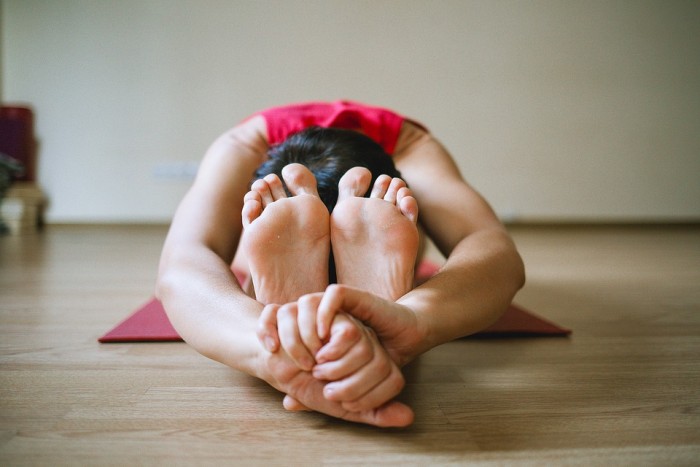Roughly seven years ago, I was in my college bookstore stocking up on winter semester textbooks when I saw a display of yoga mats. I had only been to a few yoga classes, and I hadn’t actively planned to start my own practice, but some quiet part of me must have really wanted to do yoga. That, or one of the yoga mats decided it wanted me. Without giving it a second thought, I picked up the mat and purchased it along with my American lit anthology.
From that moment, I felt a bond with my mat. Even the plastic-y smell reminded me of yoga’s calming and invigorating effects. Although I used the mat for pilates, ballet-inspired workouts, and even some Tracey Anderson-designed torture, it was always my “yoga mat.”
How to Choose a Yoga Mat
The following is a more rational breakdown of how to choose a yoga mat—what to look for in terms of material, thickness, and durability. If your yoga practice has a spiritual or intuitive component, I recommend that you go to a store (or stores) that sells yoga mats and actually touch the mats, smell the mats, and hold the mats. You never know…one just might choose you!
Also, regardless of any special connection you may hope to have with your mat, spend a few minutes thinking about the nature of your practice. Do you perform rigorous flows or generally opt for slow and restorative poses? Do you travel frequently and want to do yoga on-the-go? Do you do hot yoga and sweat quite a bit? Keep your answers to these questions in mind as you think about your desired qualities in a mat.
Thickness and portability. The standard mat is ⅛” thick. This thickness provides solid contact with the floor, which is important for maintaining balance in poses like “tree.” This is the recommended thickness if you’re planning to do flowing practices (like vinyasa) that often involve balances. A ¼”-thick mat is best for slower, restorative poses since it provides more cushion. The added cushion may make balancing poses a bit more challenging, however. This mat will be heavier than a ⅛”-thick mat of the same material. Finally, a 1/16”-thick mat is a good travel option. A mat of this thickness is likely to be lightweight and easier to fold.
Material. Mats come in a variety of materials. The most common is PVC (“vinyl”). These have the most give and sponginess. You are probably familiar with this material if you’ve been to a yoga class and borrowed one of the mats available at the studio. Other mat materials include jute, organic cotton, thermoplastic elastomer (TPE)—a man-made blend of plastic and rubber polymers designed to be more eco-friendly than PVC, recycled rubber, and natural rubber. Jute and cotton mats have the least amount of sponginess/give. If you have allergies to latex, avoid a natural or recycled rubber mat.
Texture and “stickiness.” To minimize slipping and sliding, look for a mat with a raised, tactile pattern. This is especially important if your practice includes any balances. I have read mixed comments about which material of mat provides the most safety as far as slipping-and-sliding goes. PVC mats are often described as the stickiest—and they certainly feel kind of sticky on your fingers!—but these may become slippery when you’re rocking a sweaty practice. This has been true in my experience. Eco-friendly mats may not have the same traction on the floor as a “sticky” PVC mat, but they are said to have better grip on your skin (this is particularly true of TPE and rubber mats). I have practiced on a new natural rubber mat and felt my feet slip when they got a little sweaty, but the more I used the mat, the less of a problem this became.
If you begin slipping on your mat, take a moment to wipe the excess sweat from your body and mat. Lay a microfiber yoga towel on your mat to create a sweat barrier and improve traction.
Durability. PVC mats are the most durable and may last for a decade—unless you frequently take yours to hot yoga, where the hot temps tend to break PVC mats down more quickly. TPE and other eco-friendly mats may be slightly less durable but these are more sustainable than PVC mats, which are difficult and costly to recycle.
(A little side note: My cat loved to scratch (and tear) my PVC mat (ugh), but has shown no interest in my rubber mat. For me, feline-behavior-towards-mat is a major durability factor.)
Price. The price of a mat may depend on its brand as much as its quality, so I recommend reading reviews of any mat you’re interested in and trying to get a sense of the company ethos—do they stand for the same things that you do? Are they eco-friendly? Committed to philanthropy?
Since your yoga mat will likely last you for hundreds of practices—if not thousands—it’s fair to say that it’s something worth investing in. That said, you can easily find a high-quality mat for under $100.
Design and color. You’ll be seeing a lot of your yoga mat from Downward-Facing Dog, so choose a color/design that you love—or let it choose you 🙂 When I finally replaced my old mat, I chose one with a similar pattern and color (kind of a painted-on teal). To me, the color is tranquil and feminine and just my style.
Did I miss anything, veteran yogis? Any good tips on choosing a mat?
Related: DIY Yoga Mat Spray
7 Yoga Poses for a Scattered Mind
Get more like this–sign up for our newsletter for exclusive inspirational content!
Photo: Jeviniya via Pixabay





